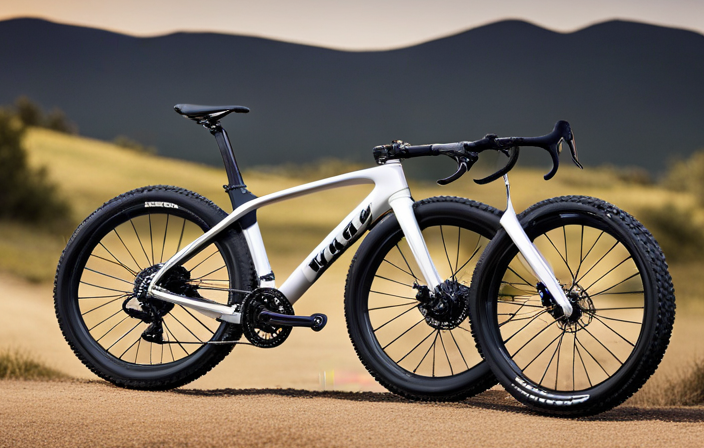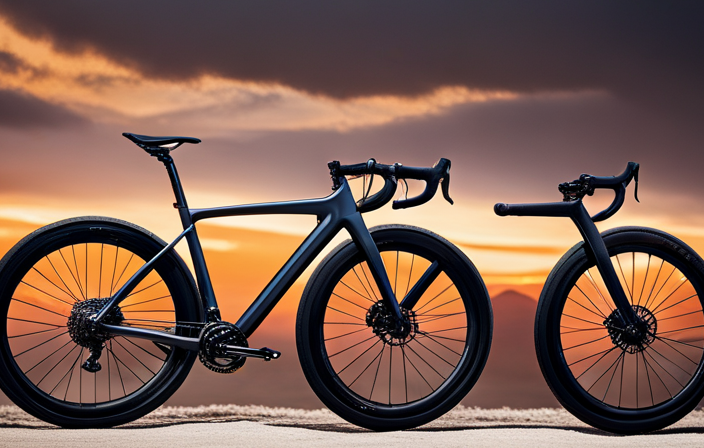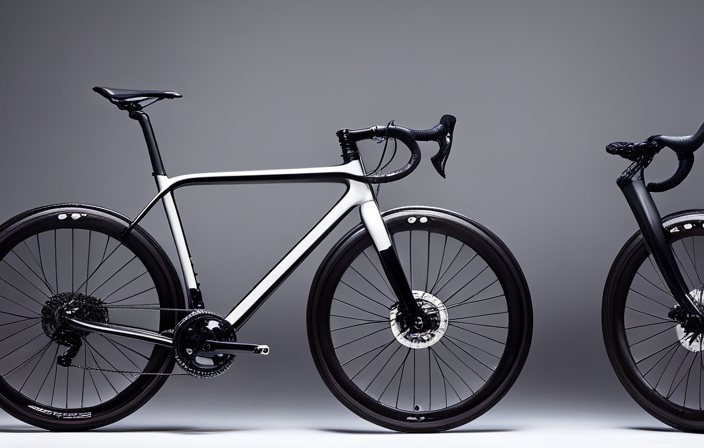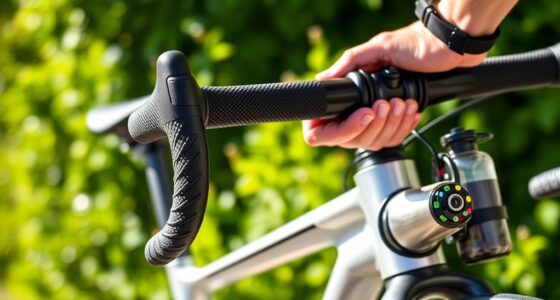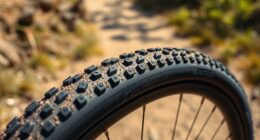The phrase goes, ‘Having the right tires can greatly impact your gravel bike experience.’ Selecting the top gravel bike tires is essential for handling rough terrain and tackling tough trails.
With factors like riding style, terrain, tire width, casing durability, and tread pattern to consider, finding the perfect balance of performance and comfort becomes paramount.
In this article, I will delve into these aspects and provide you with expert advice on selecting the ultimate gravel bike tires for your adventures.
Key Takeaways
- Riding style and terrain determine the right tires
- Tire width affects comfort and performance
- Tubeless or tubed tires have different advantages
- Puncture protection features are crucial for uninterrupted rides
Consider Your Riding Style and Terrain
Consider your riding style and terrain when choosing the best gravel bike tires. Your riding techniques and gear selection are crucial factors in determining the right tires for your gravel adventures. Gravel riding requires a versatile tire that can handle various surfaces, such as loose gravel, dirt roads, and even pavement.
If you enjoy aggressive off-road riding with fast descents and technical climbs, opt for a tire with excellent traction and durability. Look for a tread pattern that offers solid grip on loose surfaces while still providing stability on harder terrains. These tires often have larger knobs or a more aggressive tread design.
On the other hand, if you prefer smoother gravel paths or long-distance touring, prioritize comfort and rolling efficiency. Choose tires with smaller knobs or a smoother center tread to reduce rolling resistance, allowing you to maintain speed without expending excessive energy.
Additionally, consider the width of your tires as it affects both comfort and performance. Wider tires provide better grip and shock absorption but may sacrifice some speed on smooth surfaces. Narrower tires excel in speed but may be less forgiving on rough terrains.
In conclusion, finding the best gravel bike tires involves understanding your specific needs based on your riding style and terrain preferences. By considering these factors along with tire width options, you can select the perfect set of tires to enhance your gravel biking experience.
Choose the Right Tire Width
When choosing the right tire width for your gravel ride, it’s important to take into account factors such as terrain and desired performance. The width of your tires can greatly impact your bike handling and overall riding experience. A wider tire provides more stability and control on rougher terrains, while a narrower tire offers better speed and efficiency on smoother surfaces.
To help you make an informed decision, here is a table comparing different tire widths and their effects:
| Tire Width | Impact on Bike Handling | Effect on Speed and Efficiency |
|---|---|---|
| 32mm | Better maneuverability | Reduced rolling resistance |
| 40mm | Increased stability | Moderate rolling resistance |
| 50mm | Excellent traction | Higher rolling resistance |
| 60mm | Maximum shock absorption | Slower speed |
| 2.1 inches | Extreme off-road grip | Significant drag |
As you can see, the wider the tire, the more it impacts bike handling and reduces speed and efficiency. It’s important to find a balance that suits your riding style and terrain.
When considering the next step about opting for tubeless or tubed tires, it’s crucial to understand how these choices interact with your chosen tire width.
Opt for Tubeless or Tubed Tires
To get the most out of your ride, you should decide whether to go with tubeless or tubed tires. Both options have their pros and cons, so it’s important to consider your own preferences and riding style.
Here are some key points to consider when choosing between tubeless and tubed tires:
- Tubeless tires offer better puncture resistance, as they don’t require an inner tube that can be easily pierced by sharp objects on the road or trail.
- Tubed tires are generally easier to install and repair, as they don’t require the use of sealant or special rim tape.
Tubeless setups allow for lower tire pressures, providing a smoother ride over rough terrain and improved grip on loose surfaces.
- Tubed tires tend to be more cost-effective upfront, as you don’t need tubeless-specific rims or valves.
- Tubeless systems can be a bit more finicky to set up initially, but once dialed in, they require less maintenance overall.
When making your decision between tubeless and tubed tires, it’s important to weigh these factors against your own riding needs. Ultimately, the choice comes down to personal preference and what type of riding you plan on doing.
Looking for tires with durable casings is another crucial step in ensuring a great gravel riding experience.
Look for Tires with Durable Casings
One important factor to keep in mind is the durability of the tire casing. When it comes to gravel biking, having a tire with a durable casing can make all the difference in terms of performance and longevity. A strong casing not only helps protect against punctures and cuts, but also ensures that the tire remains stable and reliable on rough terrains.
There are several benefits to selecting tires with durable casings. Firstly, they provide added protection against sharp objects that you may encounter while riding off-road. This means fewer chances of getting stranded due to a flat tire or having to constantly replace tubes. Secondly, a strong casing contributes to better traction and control, allowing you to confidently maneuver through challenging terrain without worrying about tire damage.
To fully benefit from a durable casing, it’s essential to select an appropriate tire pressure based on your weight and riding conditions. Running too low pressure can increase the risk of pinch flats and sidewall damage, while running too high pressure can result in decreased traction and discomfort.
Pay attention to the tread pattern for optimal performance on different surfaces without compromising durability.
Pay Attention to Tread Pattern
Choosing tires with a suitable tread pattern is essential for ensuring optimal performance on various surfaces while maintaining durability. When it comes to gravel bikes, the right tread pattern can make all the difference in terms of grip and traction. A thorough tread pattern analysis is crucial before making a purchase decision.
The tread pattern refers to the design on the surface of the tire that makes contact with the ground. It plays a significant role in determining how well your bike will handle different terrains. A more aggressive tread pattern with larger knobs or lugs provides better traction on loose gravel or muddy trails, allowing you to maintain control and stability. On the other hand, a smoother tread pattern with smaller knobs is ideal for paved roads as it reduces rolling resistance and increases speed.
Additionally, it’s important to consider how different tread patterns impact durability. Tires with a more intricate or softer rubber compound tend to wear out faster, especially if you frequently ride on rough surfaces. On the contrary, tires with harder compounds may sacrifice some grip but offer increased longevity.
When choosing gravel bike tires, paying attention to the tread pattern is paramount for achieving an enjoyable riding experience across diverse terrains. However, it’s also crucial to prioritize grip and traction when making your final decision.
Prioritize Grip and Traction
A crucial factor to consider when selecting tires is prioritizing grip and traction for an optimal riding experience. As a passionate gravel cyclist, I understand the importance of having tires that provide excellent grip on various surfaces. Gravel riding often involves navigating through loose dirt, mud, and slippery terrain, so having reliable traction is essential.
To maximize grip and traction, it’s important to choose tires with the right tread pattern and design. Different riding techniques may require different tread patterns. For example, if you prefer aggressive cornering or tackling technical descents, look for tires with larger knobs and more spaced-out tread patterns. On the other hand, if you prioritize speed on smoother surfaces, opt for a tire with smaller knobs and a smoother center section.
In addition to tread pattern, tire pressure also plays a significant role in optimizing grip and traction. Finding the right tire pressure can be a bit of trial and error as it depends on factors like rider weight, terrain conditions, and personal preference. Lower tire pressures generally offer better traction by increasing the contact patch between the tire and the ground.
Considering puncture protection features is another crucial step in choosing gravel bike tires (as mentioned earlier). These features ensure that your rides aren’t interrupted by annoying flats caused by sharp rocks or thorns on the trail.
Transitioning into the next section about ‘consider puncture protection features,’ it’s important to find tires that not only prioritize grip and traction but also provide adequate defense against potential punctures during your gravel adventures.
Consider Puncture Protection Features
When it comes to gravel biking, grip and traction are essential for a safe and enjoyable ride. But another factor that should not be overlooked is puncture protection. Imagine being in the middle of nowhere with a flat tire – not exactly the adventure you had in mind, right? That’s why considering puncture protection features when choosing gravel bike tires is crucial.
To ensure durability and minimize the risk of flats, manufacturers subject their tires to rigorous puncture resistance testing. These tests simulate various real-world conditions such as sharp rocks, thorns, and glass shards. Tires with higher levels of puncture protection will have additional layers or reinforced sidewalls that can withstand these hazards.
However, it’s important to note that even the most puncture-resistant tires are not invincible. Proper tire pressure plays a significant role in preventing flats as well. Maintaining optimal tire pressure ensures better shock absorption and reduces the chances of pinch flats caused by hitting sharp edges on rough terrain.
Now that we’ve covered the importance of grip, traction, and puncture protection, let’s move on to our next consideration: looking for lightweight options that won’t compromise performance or reliability.
Look for Lightweight Options
For a more enjoyable ride, it’s important to consider lightweight options that won’t compromise performance or reliability. When it comes to gravel bike tires, opting for lightweight options can offer several advantages.
First and foremost, lighter tires can significantly enhance your overall riding experience by reducing the rotational weight of your bike. This means quicker acceleration, easier climbing, and improved maneuverability on challenging terrains.
However, it’s essential to strike a balance between weight and durability when selecting lightweight tires. While lighter options may provide better performance, they might not be as robust as heavier alternatives. It’s crucial to find a tire that offers the perfect blend of both qualities.
One advantage of lightweight tires is their ability to absorb vibrations more effectively than heavier ones. This results in a smoother and more comfortable ride over rough surfaces. Additionally, these tires offer better traction on loose gravel or dirt roads due to their reduced mass.
In conclusion, considering lightweight options for your gravel bike tires can greatly enhance your riding experience without compromising performance or reliability. Finding the right balance between weight and durability is key in ensuring optimal performance on various terrains.
With this in mind, let’s now explore another important aspect – rolling resistance – which plays a significant role in tire selection and overall biking efficiency.
Consider Rolling Resistance
Considering rolling resistance is an important factor when selecting tires for your gravel bike. Rolling resistance refers to the amount of energy required to keep the tires moving forward on the road or trail. It can greatly affect your overall biking experience, including speed, efficiency, and comfort.
To minimize rolling resistance, there are a few key factors to consider. First, tire pressure plays a crucial role. Finding the right balance between grip and low rolling resistance is essential. Higher tire pressures generally reduce rolling resistance but may sacrifice traction on loose surfaces. Experimenting with different pressures can help you find the sweet spot.
Secondly, tire compound also affects rolling resistance. Softer compounds tend to offer better grip but can increase friction and rolling resistance. Harder compounds decrease rolling resistance but may compromise grip in certain conditions.
Lastly, tire width can impact aerodynamics and weight distribution. Narrower tires tend to have lower rolling resistance due to reduced surface area in contact with the ground. However, wider tires provide more stability and better cushioning over rough terrain.
In conclusion, considering factors like tire pressure, tire compound, and tire width will help you find gravel bike tires with optimal rolling resistance for your riding style and preferences.
Moving on to checking for sidewall protection…
Check for Sidewall Protection
To ensure durability, it’s important to check if the tires have sidewall protection. Sidewall protection plays a crucial role in preventing damage to your gravel bike tires. When riding on rough terrain or encountering sharp objects, such as rocks or thorns, the sidewall of the tire is vulnerable to punctures and cuts. By choosing tires with robust sidewall protection, you can minimize the risk of flats and extend the lifespan of your tires.
One significant advantage of tubeless tires is that they often come with enhanced sidewall protection. Tubeless technology eliminates the need for an inner tube by relying on a sealant that fills any punctures automatically. This design not only reduces rolling resistance but also provides additional support to the sidewalls, making them more resistant to cuts and abrasions.
There are different types of sidewall protection available in gravel bike tires. Some manufacturers use thicker layers of rubber or nylon fabric to reinforce the sidewalls, while others incorporate specialized materials like Kevlar or Aramid fibers for added strength.
| Type | Description |
|---|---|
| Rubber Reinforcement | Thicker layers of rubber provide excellent durability and puncture resistance. |
| Nylon Fabric | Embedded nylon fabric enhances overall strength and protects against cuts and abrasions. |
| Kevlar/Aramid Fibers | These high-strength materials offer exceptional resistance to sharp objects without compromising weight or flexibility. |
Considering these advantages, it’s essential to choose gravel bike tires with effective sidewall protection that suits your riding style and conditions. By doing so, you can confidently explore rugged terrains without worrying about tire damage.
Moving forward into considering brand reputation when selecting gravel bike tires…
Consider the Brand Reputation
When it comes to choosing the best gravel bike tires, one crucial aspect to consider is sidewall protection. A strong and durable sidewall can prevent punctures and cuts caused by sharp rocks or debris on rough terrain.
But now, let’s shift our focus to another important factor: brand reputation. Considering the brand reputation is essential because it reflects the quality and reliability of the tires. Reputed brands have spent years perfecting their craft, developing innovative technologies, and earning the trust of cyclists around the world. Opting for a well-known brand ensures that you are investing in a product that has been tested and proven on various surfaces.
Furthermore, tire durability goes hand in hand with brand reputation. Reputable brands strive to create long-lasting tires that can withstand challenging conditions without compromising performance. These tires are designed to resist wear and tear while providing excellent grip and control.
Now that we’ve discussed considering the brand reputation and tire durability, let’s move on to another vital step: reading reviews and user feedback. It’s crucial to gather insights from fellow riders who have experienced these tires firsthand before making your final decision.
Read Reviews and User Feedback
One important step is to check out reviews and user feedback for the tires. This will give you an idea of how well they perform in real-world conditions and what other riders have experienced. When reading reviews, pay attention to the pros and cons of different gravel bike tire materials.
Some tires are made with softer rubber compounds that provide better grip on loose surfaces but may wear out faster on pavement. Others use harder compounds that offer longer lifespan but sacrifice some traction. It’s important to find a balance that suits your riding style and terrain.
User feedback can also provide valuable insights into the impact of tire pressure on gravel bike performance. Different tire pressures can greatly affect how the bike handles on various surfaces. Higher pressures generally result in better rolling efficiency on hard-packed dirt or asphalt, while lower pressures offer increased traction and comfort on rougher terrain. Finding the right tire pressure for your weight, riding style, and terrain is crucial for getting the most out of your gravel bike.
After researching online, it’s a great idea to consult with local bike shops or experts who have firsthand experience with different gravel bike tires. They can offer personalized recommendations based on your specific needs and preferences. Transitioning into this next step will help ensure you make an informed decision about which tires are best suited for your gravel adventures without wasting time or money trying out multiple options blindly.
Consult with Local Bike Shops or Experts
Consider reaching out to local bike shops or experts who have firsthand experience with different tire options for personalized recommendations based on your specific needs and preferences. When it comes to choosing the best gravel bike tires, there is no one-size-fits-all solution. The right tire for you will depend on factors such as the type of terrain you plan to ride on, your riding style, and your personal preferences.
Bike shop recommendations can be invaluable in helping you navigate through the wide range of options available today. Local bike shops often have knowledgeable staff members who are passionate about cycling and can provide expert opinions based on their own experiences and feedback from other customers. They can guide you towards tires that are known for their durability, grip, puncture resistance, and overall performance.
Experts in the field of gravel biking can also provide valuable insights into tire selection. These individuals have extensive knowledge about various brands and models of tires and can recommend options that align with your specific requirements.
By consulting with local bike shops or experts, you can tap into a wealth of knowledge that will help you make an informed decision when choosing gravel bike tires. Once armed with these recommendations, you’ll be better equipped to test different tires if possible without feeling overwhelmed by the sheer number of options available.
Test Different Tires if Possible
If possible, try out various tire options to determine which ones suit your needs and preferences. Testing different brands and comparing tread patterns is crucial when it comes to finding the best gravel bike tires. Each brand offers its own unique features and characteristics that can significantly impact your riding experience.
When testing different tires, pay attention to how they handle on different terrains. Some tires may excel in muddy conditions, while others may provide better traction on loose gravel or pavement. By testing different options, you’ll gain a firsthand understanding of how each tire performs in various situations.
Additionally, consider the tread pattern of each tire. Different tread patterns are designed for specific purposes, such as providing grip on wet surfaces or reducing rolling resistance on smooth roads. Compare the tread patterns of different brands and see which one aligns with your riding style and terrain preferences.
By testing different tires and comparing their performance, you can find the perfect balance of performance and comfort for your gravel biking adventures. This will ensure that you have a reliable set of tires that enhance your overall riding experience without compromising your safety or enjoyment on the trails ahead.
Find the Perfect Balance of Performance and Comfort
To find the perfect balance of performance and comfort, it’s important to test different tires and compare their tread patterns and handling on various terrains. One crucial aspect to consider is the importance of tire pressure. The right pressure can greatly impact the overall ride quality and performance of your gravel bike. It affects how well the tire grips the ground, how it rolls over obstacles, and even how comfortable your ride feels.
When testing different tires, pay close attention to the impact of tire tread on handling. The tread pattern plays a significant role in how well a tire handles different surfaces. A more aggressive tread pattern may provide better traction on loose or muddy terrain but might sacrifice some speed on smoother surfaces. On the other hand, a smoother tread pattern may excel in faster rolling speed but could struggle in slippery conditions.
By testing various tires with different tread patterns and adjusting tire pressures accordingly, you can find that sweet spot where performance meets comfort. It’s all about finding that perfect combination that suits your riding style and preferences while providing optimal grip and control across different terrains.
So don’t be afraid to experiment and discover which combination works best for you!
Frequently Asked Questions
Are gravel bike tires suitable for road cycling?
Yes, gravel bike tires can be suitable for road cycling. While they may not offer the same level of speed and efficiency as dedicated road bike tires, they can still provide a smooth and comfortable ride on paved surfaces.
It’s important to adjust the tire pressure accordingly for optimal performance on the road. Lowering the pressure slightly can enhance traction and absorb vibrations, ensuring a more enjoyable experience while riding on pavement.
How often should I replace my gravel bike tires?
When it comes to replacing gravel bike tires, there isn’t a set timeframe as it depends on various factors. However, there are some signs to look out for.
Inspect the tread pattern regularly and replace them when they become worn down or show signs of cracking.
Additionally, consider the type of terrain you ride on. If you frequently ride on rough gravel roads, wider tires with a more aggressive tread pattern may be better suited for enhanced grip and stability.
Can I use a different tire width than what is recommended for my gravel bike?
Absolutely!
While it’s important to follow the manufacturer’s recommendations, experimenting with different tire widths can enhance your gravel bike experience.
Just imagine the freedom of floating on clouds or effortlessly gliding across rough terrain like a mythical creature!
However, keep in mind that altering tire width will affect the overall bike handling and may require adjustments to tire pressure.
So, proceed with caution and find the perfect balance for an epic ride!
What are the benefits of tubeless tires for gravel riding?
There are several advantages to using tubeless tires for gravel riding. Firstly, they allow you to run lower tire pressures, providing increased traction and a smoother ride over rough terrain.
Tubeless tires also reduce the risk of flats caused by punctures, as the sealant inside the tire can quickly seal small holes.
However, it’s important to note that setting up tubeless tires can be more complicated and time-consuming compared to traditional clincher tires.
How do I determine the ideal balance between performance and comfort when choosing gravel bike tires?
When it comes to finding the ideal balance between performance and comfort in gravel bike tires, there are a few key factors to consider.
Firstly, you’ll want to assess your priorities: are you more concerned with speed and performance or durability? Once you’ve determined that, tire pressure optimization becomes crucial.
Finding the right pressure for your tires can greatly impact both comfort and performance on different terrains. It’s all about finding that sweet spot that maximizes your ride experience and allows you to conquer any gravel adventure with confidence.
Conclusion
After carefully considering my riding style and terrain, I have chosen the right tire width. I have also researched the best options in terms of tubeless or tubed tires, durable casings, tread pattern, and user feedback. Choosing the perfect gravel bike tires is an art, as they say, ‘The devil is in the details.’ This rings true when it comes to balancing performance and comfort on your gravel adventures.
So go forth with confidence on your trusty steed. You can be assured that you have made the best choice for your cycling needs.
